Are you ready to embark on a wild and whimsical journey through the world of brown animals? Well, hold on tight because we’ve got a lineup of 12 fascinating creatures that are bound to make you say, “Wow, I never knew brown could be so cool!” From the mighty grizzly bears, who rule the North American wilderness with their majestic presence, to the camouflaged cougars, who stealthily prowl the Americas, these brown animals are anything but ordinary. And hey, did you know that the capybara holds the title for being the largest rodent? Yep, forget about those pesky squirrels, we’re talking about a rodent the size of a dog! So, get ready to meet the resilient bactrian camels, the elusive fossa of Madagascar, and even the timid brown widow spider. With pictures and fun facts galore, this blog post is your ultimate guide to the fascinating world of brown animals. So, let’s dive in and discover the wonders of these earth-toned wonders!
Grizzly Bears: The Mighty Brown Titans of North America
In the wilderness of North America, amidst the rugged mountains and the dense forests, resides a creature of remarkable strength and astonishing speed – the Grizzly Bear. This subspecies of the brown bear, aptly named for the ‘grizzled’ appearance of its fur, is a symbol of the untamed spirit of the continent.
Read all about: Male Tiger vs. Female Tiger: Unmasking the Secrets of Telling Them Apart
Despite their colossal size, these bears can reach a speed of up to 35 miles per hour, a testament to their surprising agility. Their diet, as varied as the landscapes they call home, is truly a testament to their adaptability. From berries and roots to fish and mammals, these omnivores have a palate as diverse as nature itself.
| Grizzly Bear Quick Facts: | |
|---|---|
| Scientific Name: | Ursus arctos horribilis |
| Type of Animal: | Mammal |
| Native To: | North America |
| Max Speed: | 35 mph |
| Diet: | Omnivore |
The distinctive hump of muscle on their shoulders is not just for show. It aids them in one of their most crucial behaviors – digging. Whether it’s foraging for roots or preparing dens for their winter hibernation, their muscular hump proves to be an invaluable tool.
Grizzly Bears are typically solitary creatures, each requiring a large territory to roam. Mothers, however, are often seen nurturing their cubs, showcasing a softer side to these powerful predators. As apex predators, they play a vital role in maintaining a healthy balance in their ecosystem. Their presence ensures the population of their prey species is kept in check, contributing to the overall harmony of their habitat.
Embodying the raw power and the untamed spirit of the wilderness, the Grizzly Bear is truly a fascinating creature. As we delve further into the world of brown animals, let’s keep in mind the important role each of these creatures plays in the intricate web of life.
Cougars: The Camouflaged Predators of the Americas

cougar
From the high peaks of the Rocky Mountains to the dense rainforests of the Amazon, a solitary figure moves stealthily. It is none other than the Cougar—also known as the Mountain Lion or Puma. Resplendent in a uniform tawny brown coat, it is the embodiment of natural camouflage, a master of disguise in the vast wilderness of the Americas. This majestic creature, with its far-reaching territories extending from the cold Canadian Yukon to the southernmost Andes, boasts the largest distribution of any big cat in the Western Hemisphere.
Unlike their roaring relatives, Cougars communicate not with a thunderous roar, but with a symphony of low-frequency purrs, growls, hisses, and whistles. This unique vocal repertoire, paired with their muscular bodies and extraordinary athleticism, makes them a fascinating subject of study.
Read more: How Fast Can a Cheetah Run? Unveiling the Secrets Behind Its Incredible Speed
With their long, robust hind legs, Cougars are capable of impressive feats of agility and strength, leaping as high as 15 feet and sprinting with a speed that rivals the fleetest deer.
These creatures are not just brawn, though. They are apex predators, solitary and territorial, with a keen sense of their surroundings. As twilight descends and dawn breaks, Cougars spring to life, their activities peaking during these crepuscular hours.
Their diet primarily consists of deer, but the versatile Cougar can adapt to changing circumstances, eating smaller prey if necessary. In fact, their presence plays a crucial role in controlling ungulate populations. They are the unseen guardians of the ecosystem, their presence an indicator of balance and health in the wilderness.
As we delve deeper into the lives of these camouflaged predators, we are reminded of the intricate web of life in the Americas, where the Cougar, a creature both feared and revered, holds a place of honor. Each sighting, each soft growl in the night, adds to the rich tapestry of life in the wild, a testament to the resilience and adaptability of these remarkable creatures.
Bactrian Camels: The Resilient Dwellers of Central Asia
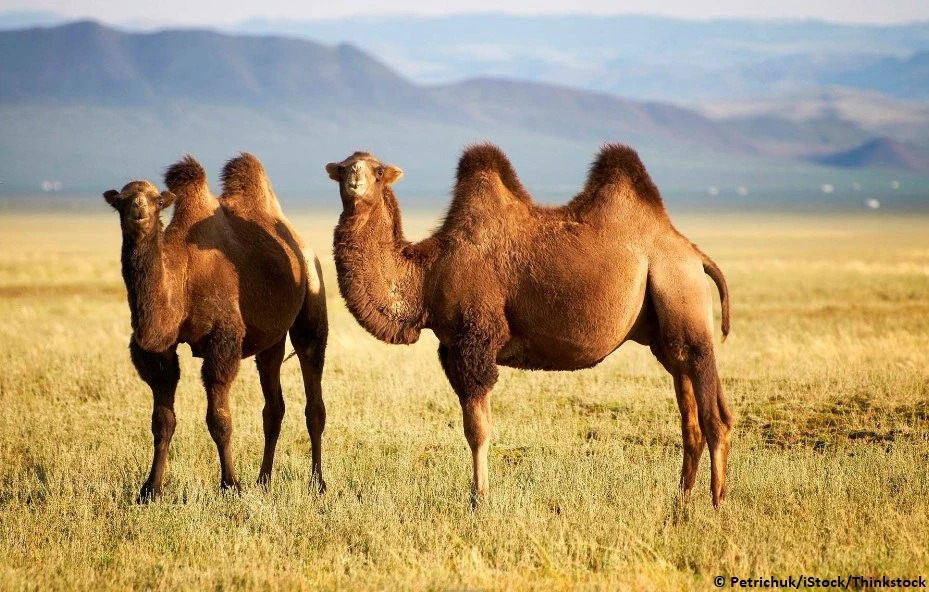
bactrian camels
As we traverse from the forests of the Americas to the unforgiving deserts of Central Asia, we encounter a unique breed of survivors, the Bactrian Camels. This peculiar species, with their distinctive shaggy coat of brown fur, is a visual spectacle in the vast desert landscape. Their fur, varying from a sandy beige to a dark brown, serves as a natural camouflage, blending effortlessly into their surroundings. But it plays an even more critical role, protecting these resilient creatures from the extreme temperature fluctuations, from scorching heat to freezing winters.
One of the Bactrian Camel’s most notable features is its humps. Dispelling the widespread myth, these humps are not water reservoirs. Rather, they are fat stores that the camel taps into during times of food scarcity, demonstrating a remarkable adaptation to their harsh environment. Think of these humps as natural storage tanks, ensuring the camel’s survival during lean periods.
Contrary to popular belief, the humps of a Bactrian Camel store fat, not water, converting it into energy when food is scarce.
For centuries, Bactrian Camels have played an integral role in the lives of desert-dwellers. They have been the lifeline for many, providing essential services like transport across the vast, sandy terrains. Moreover, they are a source of sustenance, offering milk, meat, and wool. These animals, therefore, hold a significant place in the cultural and economic fabric of Central Asia.
Check out: What Eats Vultures? Discover the Top 8 Predators that Prey on Vultures
However, the survival of the wild Bactrian Camel hangs in the balance. They are critically endangered, with hunting and habitat loss being the primary threats. We are at risk of losing this emblem of resilience from our planet’s diverse biosphere. There’s an urgent need for conservation efforts to ensure these majestic creatures continue to tread the sands of Central Asia.
As we journey further into the animal kingdom, let’s carry the image of the Bactrian Camel, a true testament to nature’s power of adaptation, and remember the crucial role we play in preserving such species.
Walruses: The Arctic Giants
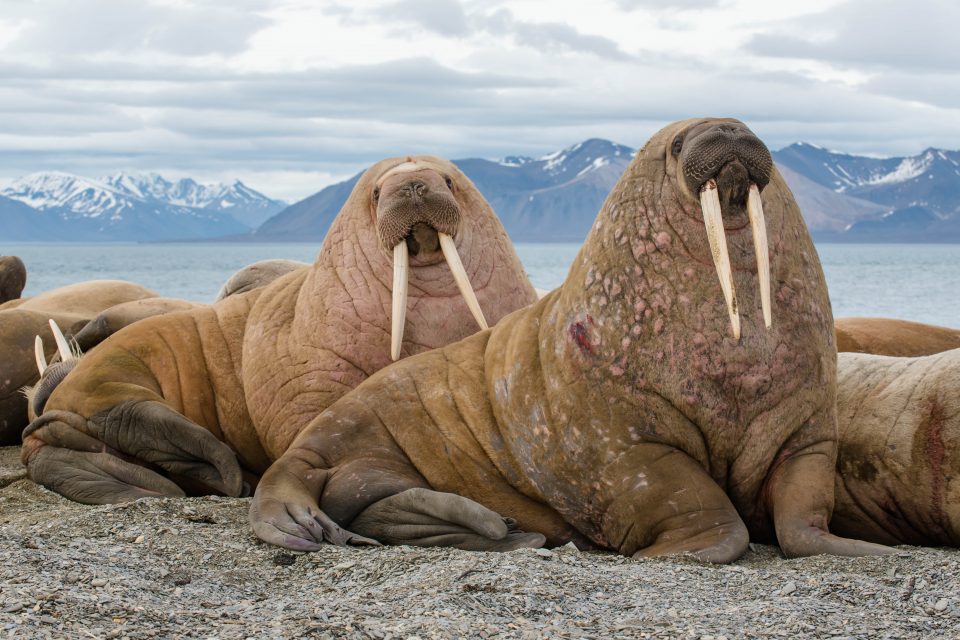
walruses
Imagine yourself in the frosty, windswept stretches of the Arctic and subarctic regions, where the air is crisp, the ice is thick, and the ocean a vast expanse of chilling beauty. Here, you encounter the majestic Walrus, a colossal creature cloaked in wrinkled brown skin and boasting long, protruding tusks—an image as iconic as it is impressive.
The walrus, a veritable giant of the Arctic, is not merely defined by its size or the length of its tusks. Beneath its weather-beaten exterior lies a fascinating tale of adaptation and survival. It’s a creature that thrives amid ice and snow, thanks to a layer of blubber that can measure up to six inches thick. This blubber acts as a life-saving blanket, providing much-needed insulation against the ruthless Arctic cold.
And what about those magnificent tusks? Far from mere ornaments, these elongated canines serve a multitude of purposes. Displayed prominently, they establish dominance among their peers, creating a hierarchy within the social structure of these animals. They also function as practical tools, enabling walruses to haul their heavy bodies out of the icy waters with surprising agility. In the face of threats, the tusks become formidable weapons, a testament to the walrus’s status as a force to be reckoned with.
Descend with the walrus into the depths of the Arctic seas, and you’ll discover a diet primarily comprised of shellfish. Thanks to their sensitive whiskers, or vibrissae, they can deftly locate their prey on the ocean floor—a remarkable adaptation that speaks volumes about their evolutionary journey.
Walruses are not solitary beings, but rather, social animals that value companionship. They often rest in large, closely packed groups on sea ice or rocky beaches, their huddled forms a testament to their communal spirit. Yet, they are more than just a gathering of Arctic giants. They are the heartbeat of the Arctic marine ecosystems, their very existence influencing the balance and health of their icy home.
In the throes of climate change, the walrus has emerged as a crucial indicator species. Their population trends and overall health serve as a mirror reflecting the state of the Arctic ecosystem. As such, the fate of these Arctic giants is inextricably linked to the broader health of our planet, making their conservation an issue of global significance.
From the resilient Bactrian Camels of Central Asia, we have journeyed into the frosty domains of the Walrus. Next, we dive into warmer climates to meet the Capybara, the largest rodent in the world. Stay tuned!
The Capybara: Unveiling the Secrets of the World’s Largest Rodent
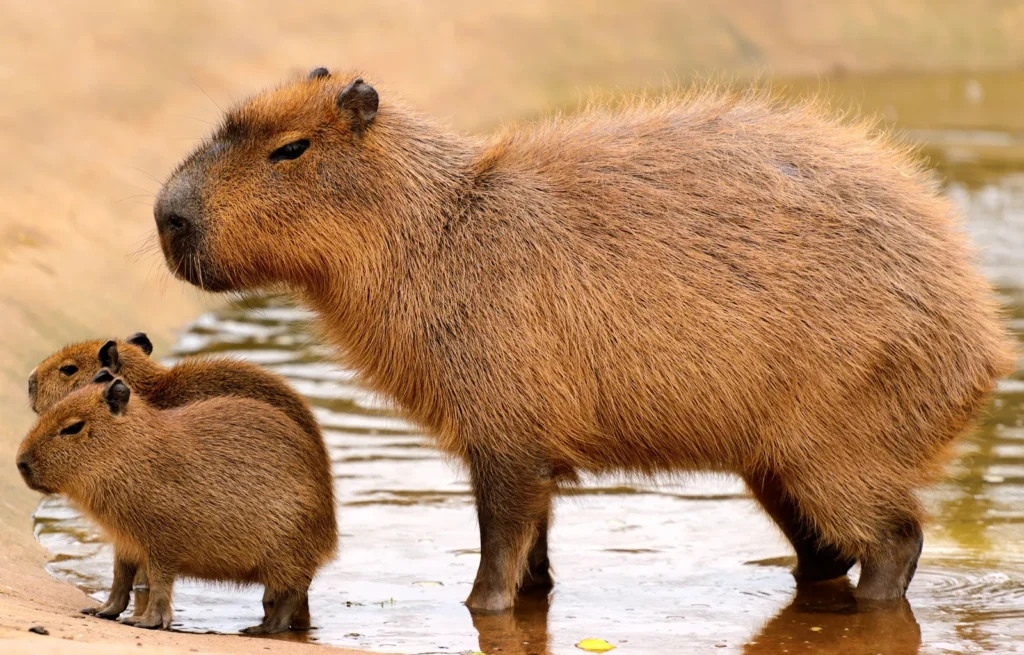
capybara
As we traverse the diverse terrains of our planet, we now find ourselves in the lush green landscapes of South America. Here, in the midst of the sprawling wetlands and tranquil rivers, nature reveals a surprising marvel – the Capybara. This gentle giant, with its reddish-brown fur glistening under the tropical sun, holds the title as the world’s largest rodent.
Our Capybara, scientifically known as Hydrochoerus hydrochaeris, is a wonder of natural adaptation. Pay close attention to its facial features – you’ll notice its eyes, ears, and nostrils are intriguingly positioned on top of its head. This unique layout is not a mere quirk of evolution. It’s a perfect adaptation to the Capybara’s semi-aquatic lifestyle, allowing it to stay submerged in water, with only a tiny fraction of its body visible above the surface.
But the Capybara’s uniqueness doesn’t stop at physical attributes. Step into their world, and you’ll be greeted by a highly social creature. Unlike many of its rodent relatives, the Capybara thrives in the company of others. It’s not uncommon to find them in large groups, their interactions painting a picture of a tight-knit community.
As the sun peeks over the horizon and again as it bids goodbye for the day, the Capybara embarks on its feeding journey. It feeds on a versatile menu: lush grasses, succulent aquatic plants, sweet fruits, and even the tough bark of trees. But this feeding habit isn’t just about survival. It’s an essential thread in the intricate tapestry of its ecosystem.
Through their diet, Capybaras serve as a conduit of life, helping distribute seeds via their droppings, and in turn, playing a vital role in maintaining the biodiversity of their habitat.
However, their role extends beyond being mere seed carriers. The Capybara, as a primary prey for many predators, is a crucial link in the food chain, underscoring the intertwined fate of the species that share its home. It’s a testament to the delicate balance of nature, where each creature, no matter how big or small, plays a pivotal role.
So, as we continue our journey through the fascinating world of brown animals, let’s carry with us the story of the Capybara – a story of adaptation, sociability, and ecological significance. As we move on to our next creature, the majestic American Bison, we will see how these themes of survival and significance echo across species and ecosystems.
American Bison: The Majestic Mammals of North America
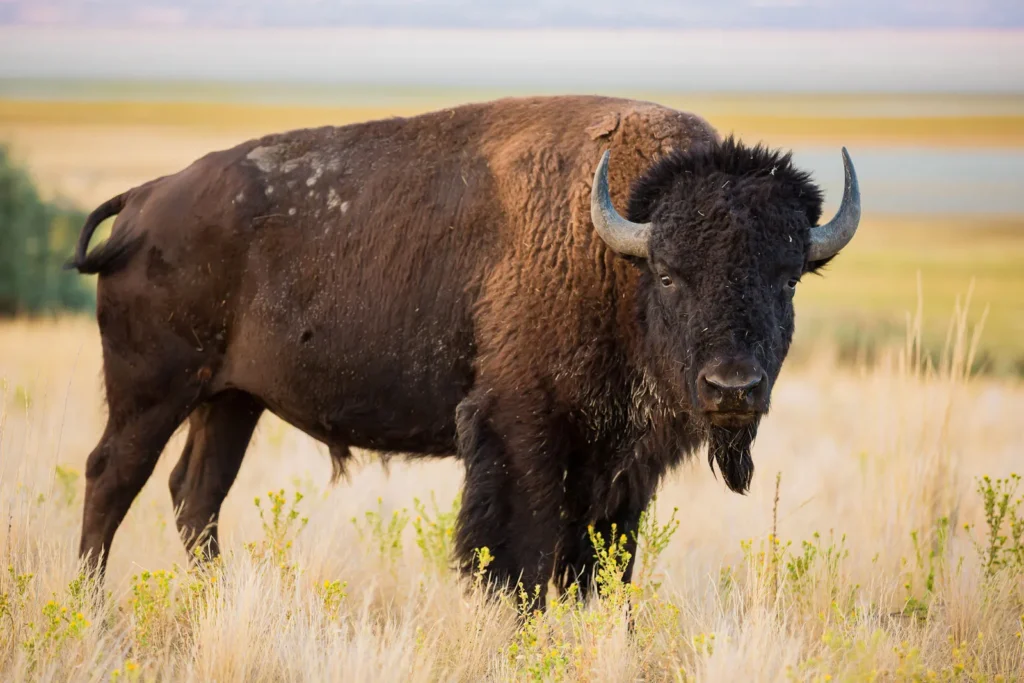
american bison
Imagine standing on the vast, wind-swept grasslands of North America. There, in the distance, you spot a hulking figure, recognized by its massive head, humped shoulders, and a shaggy, dark brown coat. You’ve just set eyes on the largest land mammal in North America – the American Bison, often lovingly referred to as the Buffalo.
These awe-inspiring creatures, with their front-heavy physique, are a sight to behold. Their fur, like a well-designed fur coat, is longer in the front than the back, providing them with a natural insulation against the blistering winters of the North American plains. As herbivores, the Bison’s diet primarily consists of grasses and sedges, which they graze upon with relentless dedication.
Once, these magnificent beasts roamed the plains in vast, thundering herds, their hooves drumming a symphony on the earth, playing a crucial role in maintaining the prairie ecosystem.
However, the 19th century brought with it a storm of overhunting, pushing these gentle giants to the brink of extinction. It’s a heartrending chapter in their history, seeing their numbers dwindle dramatically. But, like the proverbial phoenix, the Bison have risen from the ashes of their near-demise. Thanks to concerted conservation efforts, these majestic mammals have made a significant comeback. Today, they are primarily found in the safety of reserves and national parks, their herds a testament to their resilience and survival.
Yet, the Bison are more than just a species of animal. They hold a profound cultural significance for the Indigenous people of North America. To them, the Bison is not just an animal – it is a symbol of their struggle, resilience, and strength. The Bison’s story is, in many ways, their story too.
Read more: Are Raccoons Rodents? Unveiling the Truth Behind Their Classification
So, the next time you spot a Bison, remember, you’re not just looking at an animal. You’re seeing a symbol of survival, resilience, and cultural significance that’s as vast and deep as the plains they once freely roamed.
Fossa: The Elusive Predators of Madagascar
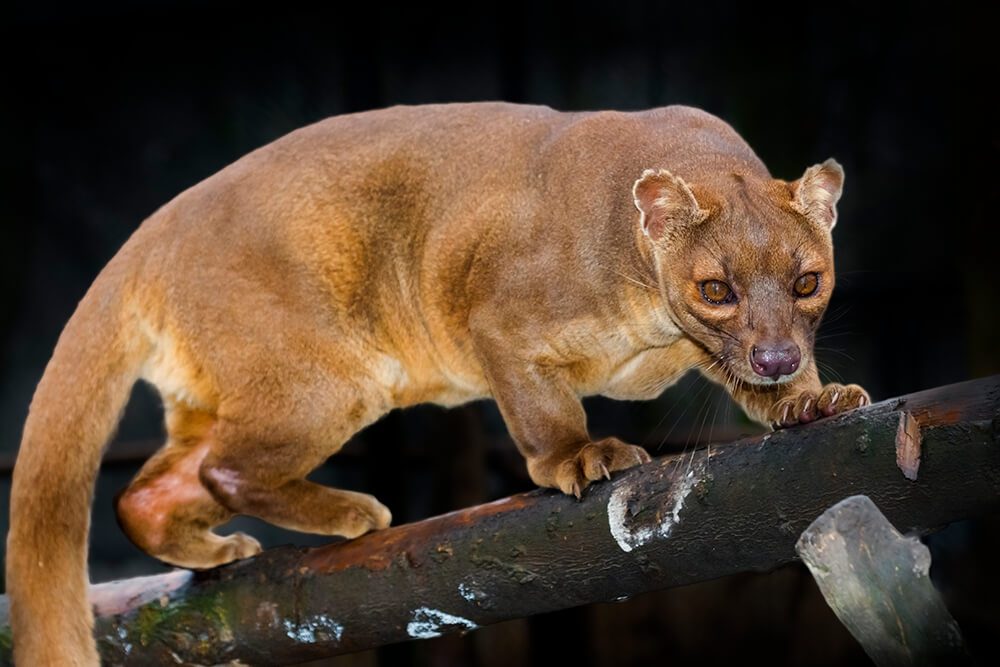
fossa
As we journey from the vast North American plains, home of the resilient Bison, we find ourselves transported to the unique biodiversity of Madagascar, a realm of endemic creatures, where the Fossa reigns as the largest mammalian carnivore. Cloaked in a reddish-brown coat, its slender silhouette might deceive you into mistaking it for a large feline. However, this elusive predator, with its fascinating genetic lineage, is more closely related to the mongoose than to any feline.
“The Fossa, a creature of contradictions – appears as a cat, behaves like a mongoose, and rules like a lion.”
What distinguishes the Fossa from other carnivores is not just its odd genetic relationships, but its remarkable physical adaptations that make it a formidable predator. With semi-retractable claws and flexible ankles, this creature is an agile climber, able to effortlessly traverse the dense forest canopies of Madagascar. Its dexterity extends beyond the trees, as the Fossa is equally adept at running on the ground. This versatility enables it to hunt a variety of both arboreal and terrestrial prey.
Marking their territories with scent glands, Fossas are solitary animals — a characteristic that only amplifies their mysterious allure. These elusive predators, often overlooked in the shadow of Madagascar’s iconic lemurs, play a crucial role in maintaining the island’s delicate ecosystem. By controlling the populations of rodents and other small mammals, they ensure a balance in the food chain, much like the Capybara, the Bison, and other animals in our series.
The Fossa: A Creature of Contrast
- Scientific name: Cryptoprocta ferox
- Type of animal: Mammal
- Where found: Madagascar
So, as we bid farewell to the Fossa, we carry forward the realization that even the lesser-known species, like this elusive predator, contribute significantly to the biodiversity of our planet. Next, we journey to another corner of the world, where we delve into the intriguing life of the Brown Widow Spider.
Brown Widow Spider: The Timid Arachnid

brown widow spider
Transitioning from the elusive Fossa, we now turn our gaze towards a smaller yet equally mesmerizing creature, the Brown Widow Spider. Akin to a tiny nocturnal artist, it weaves its world into intricate silk tapestries under the cover of darkness. This fascinating arachnid, a native to the vast landscapes of Africa, has not only survived but thrived, successfully establishing its colonies in warmer regions worldwide.
At first glance, the Brown Widow Spider might seem like a mundane creature, but its unique hues beg to differ. Its color palette is a symphony of tones, ranging from the subtlety of tan to the deep mystery of dark brown. The finishing touch to this living canvas is an iconic, hourglass-shaped marking of vibrant orange or yellowish hue that adorns the underside of its abdomen.
Despite their humble size, the Brown Widow Spiders have a fascinating approach to survival. They are primarily nocturnal creatures, their world coming alive as the sun dips below the horizon. They spend their nights tirelessly crafting intricate webs, an architectural marvel designed to ensnare their prey, which primarily consists of insects.
For those of you who might shudder at the mention of spiders, the Brown Widow might just change your mind. They are generally timid, preferring to keep to themselves and only resorting to biting when they feel threatened or disturbed. Interestingly, despite the fear commonly associated with spider venom, the Brown Widow’s venom is significantly less potent than that of the notorious Black Widow. Moreover, their smaller size results in them injecting less venom, further reducing the severity of their bites.
It’s important to remember, though, that these spiders, like the Fossa, play a crucial role in maintaining biodiversity. They keep insect populations in check, thereby contributing to the balance of their local ecosystems. As we proceed to explore more fascinating brown animals, let’s not forget the significant roles even the smallest creatures play in the grand tapestry of life.
Bongo: The Forest Antelope’s Vibrant Display
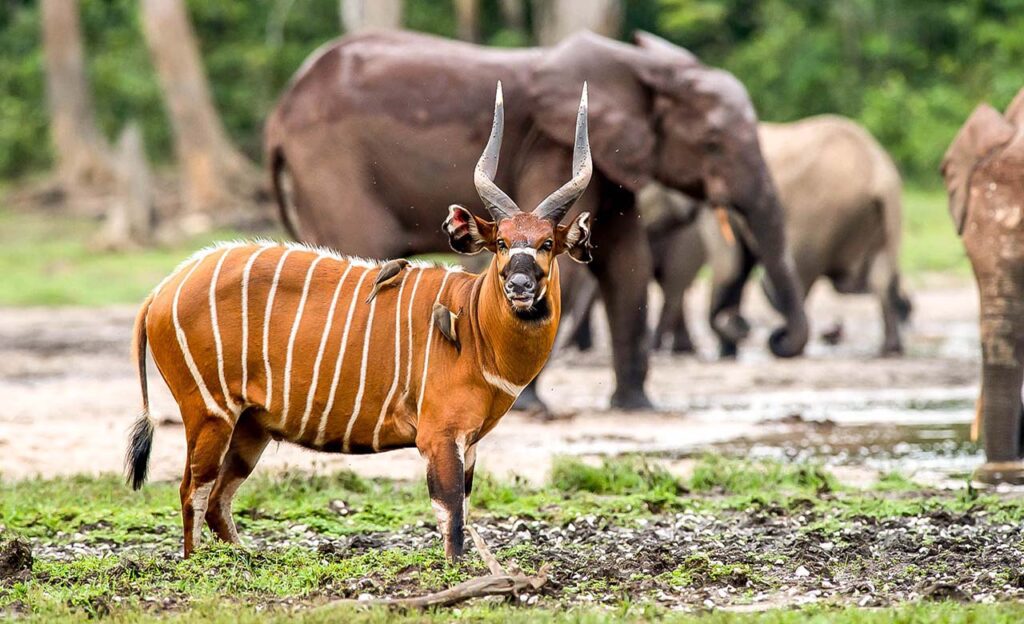
bongo
Leaving behind the tangled webs of the Brown Widow Spider, we venture into the shaded forests of West Africa, Central Africa, and Kenya to encounter a creature that is as elusive as it is captivating: The Bongo Antelope. This unstated hero of the African forests is known for its radiant chestnut or orange-brown coat, a vibrant display that mirrors the warmth of its habitat.
But there is more to the Bongo than meets the eye. A closer look reveals white stripes that break up this compelling display of colour. These stripes are not merely decorative. They serve a critical purpose, providing camouflage that allows the Bongo to blend seamlessly into the dense forest undergrowth, making it almost invisible to predators.
“The Bongo Antelope, with its vibrant chestnut or orange-brown coat and white stripes, is a master of disguise, constantly eluding the gaze of predators and researchers alike.”
Now, let’s talk about their majestic horns. Uniquely, both males and females sport long, spiral horns that lean slightly towards the back. This unusual feature is not just for show; it’s a practical adaptation to their environment. These horns help them navigate through the dense forest undergrowth with ease, avoiding obstacles and potential threats.
Primarily nocturnal, Bongos spend their nights grazing on a diet of leaves, bark, fruits, and grasses, contributing to the biodiversity of the forest ecosystem. However, their elusive and shy nature, coupled with their knack for blending into their environment, makes studying these creatures a challenge for researchers.
Unfortunately, despite their essential role in maintaining the forest ecosystem, Bongos face a significant threat: habitat loss. As human activities encroach upon these forested areas, the Bongo’s natural habitat is shrinking, posing a considerable risk to their survival.
As we journey further into the world of fascinating brown animals, let’s carry with us the image of the elusive Bongo, a radiant creature of the forest, whose survival is intricately connected with the well-being of its habitat.
Meadow Brown Butterfly: The Common Beauty Unveiled
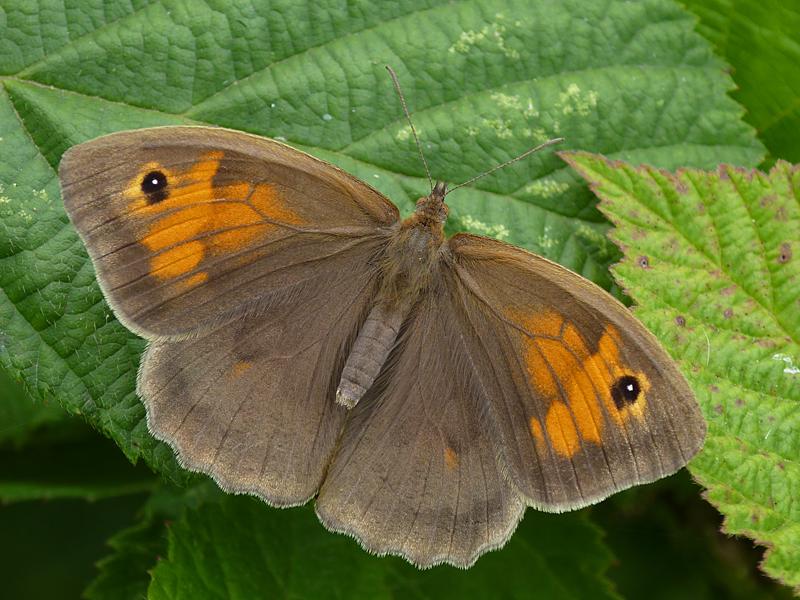
meadow brown butterfly
As we take a journey from the enchanting world of Bongo Antelopes and Brown Widow Spiders, we flutter into the lush grasslands of Eurasia and North Africa. Here, amidst the verdant expanse, a spectacle of nature unfolds – the captivating dance of the Meadow Brown Butterfly, a common yet undeniably enchanting creature of the United Kingdom.
Adorned with a brilliant tapestry of earthy hues, the Meadow Brown Butterfly is a sight to behold. Its wings, a canvas of various shades of brown, are beautifully marked with a distinctive eyespot on the upper wings. This feature is not just an aesthetic marvel but also a clever trick of nature, designed to confuse predators and provide a moment’s distraction for the butterfly to make its escape.
The females of the species, embodying the spirit of nature’s beauty, typically have brighter colors than their male counterparts. This chromatic contrast plays a significant role in their mating rituals, with the females’ vibrant colors acting as a beacon for potential mates.
The lifecycle of the Meadow Brown Butterfly is a testament to nature’s perfect balance. Each year, these butterflies grace the world with a single brood. The caterpillars, hatched from the eggs laid by the females, feed voraciously on a variety of grasses, growing and transforming until they are ready to undertake the miraculous metamorphosis into adult butterflies.
Once they’ve spread their wings, the adult butterflies feed on nectar from flowers, serving as vital pollinators. They flit from flower to flower, covered in pollen, unknowingly aiding in the reproduction of a host of plants. This intricate dance, in turn, ensures the flourishing of the very vegetation that their caterpillars will feed on, completing a perfect circle of life.
Their role doesn’t end at pollination. They also form an essential link in the food chain, serving as a valuable source of nourishment for birds and other animals. Thus, the existence of the Meadow Brown Butterfly is intricately woven into the very fabric of their ecosystem.
Despite their delicate nature, these butterflies are incredibly resilient. In the face of environmental changes, they have proven their adaptability, a testament to their survival instincts. The Meadow Brown Butterfly, in all its common beauty, truly exemplifies the wonders and intricacies of nature. Just like the elusive predators of Madagascar, the Fossa, which we will explore in the following sections, they too have a story of resilience and adaptability to tell.
European Mink: The Endangered Swimmer of Europe’s Waterways
As we transition from the terrestrial realms of the Bongo antelope and the Meadow Brown Butterfly, allow me to guide you to the riparian zones of Europe, home of the European Mink. Akin to an amphibious masterstroke of nature, this semi-aquatic mammal is an extraordinary specimen, beaming with a rich, dark brown coat. Amidst this uniform hue, a pair of distinctive white markings, gracing the upper and lower lips, stand out, lending a unique identity to this elusive creature.
The European Mink, bearing the scientific name Mustela lutreola, is a creature of the night, its life thriving under the veil of darkness. Nocturnal by nature, these agile beings patrol their territory with a keen vigilance, ensuring their domain remains unchallenged. Yet, the night also serves as a hunting ground for these skilled predators, whose diet comprises an eclectic mix of rodents, fish, birds, and amphibians.
“In the quiet of the night, the European Mink emerges, a skilled predator in the shadows, a guardian of its aquatic kingdom.”
Despite their beautifully adapted lifestyle, the European Mink faces a dire threat. Their numbers are dwindling, placing them on the brink of extinction. The root of such a bleak predicament is the relentless encroachment of their habitat by humans, and the pollution staining their fresh water havens. Additionally, they face stiff competition from their distant cousin, the American Mink, a rival as formidable as the challenges posed by their environment.
As we journey through this article, exploring fascinating brown animals, it’s essential to remember the plight of species like the European Mink. Their struggle for survival is a stark reminder of the delicate balance of nature and our role in preserving it.
Let’s continue our exploration, venturing into the melodious world of the White-Browed Bulbul in the upcoming section. Stay tuned for another fascinating encounter!
White-Browed Bulbul: The Sweet Singer
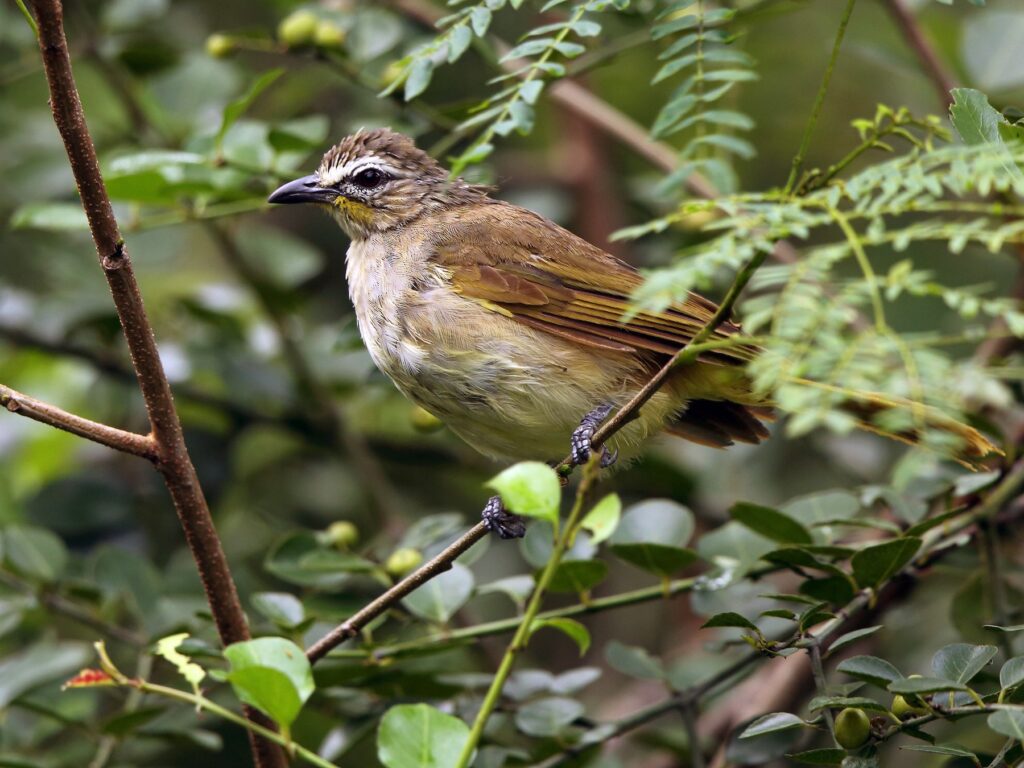
white browed bulbul
Our journey through the fascinating world of brown animals brings us to the vibrant landscapes of India and Sri Lanka, where the melodious White-Browed Bulbul thrives. This charming bird, known for its sweet, enchanting song, adds rhythm to the symphony of the wild. Its olive-brown body, coupled with a distinctive white ‘eyebrow’ and a hint of yellow at its undertail, paints a captivating picture of nature’s artistry.
Read more: What Makes an Alligator’s Bite Force So Powerful? Discover How it Measures Up Against Other Animals
Relishing a diet primarily of insects and fruits, the White-Browed Bulbul serves as nature’s little pest control agent. Their appetite for insects helps balance pest populations, while their fondness for fruit aids in seed dispersal, contributing to the growth and spread of plants in their habitats. This underlines the intricate interconnectedness of the ecosystem and the crucial role each species plays.
“Often seen in pairs or small groups, the White-Browed Bulbul symbolizes the spirit of community in the wild.”
These birds are gregarious and sociable, often spotted in pairs or in small, lively groups. They are a testament to the spirit of unity in the wilderness. But what’s more impressive is their ability to adapt. The White-Browed Bulbul has learned to coexist with humans, thriving not just in the untouched wilderness, but also in urban environments. It’s a perfect example of the resilience and adaptability that wildlife often needs to display in a rapidly changing world.
In the grand orchestra of nature, the White-Browed Bulbul plays its sweet melody, reminding us of the diverse beauty that resides within our planet’s brown animals. From the mighty Grizzly Bear, the resilient Meadow Brown Butterfly, to now this melodious bird, each species tells a unique story of survival, adaptation, and ecological significance. Let’s continue to unravel these stories, for within them lie the secrets to preserving our planet’s rich biodiversity.
The article discusses 12 fascinating brown animals, including Grizzly Bears, Bactrian Camels, Walruses, Capybaras, American Bison, Fossas, Brown Widow Spiders, European Minks, and White-Browed Bulbuls.
Brown is a common color in nature because it provides camouflage for many species, allowing them to blend into their habitats and increase their chances of survival.
Brown animals can be found in various habitats, including forests, deserts, plains, and Arctic and subarctic regions.
Grizzly Bears play a vital role in their ecosystem as apex predators. They help maintain a healthy balance of animals by controlling populations and contributing to nutrient cycling through their feeding habits.

